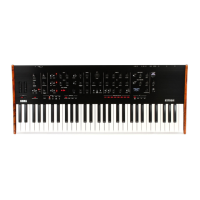56
Type 1 This curve requires you to play strongly in order to produce an
eect.
Type2,3
...
Type 4 This is a typical curve.
Type 5
...
Type 6 Thiscurveproducesaneectwithoutrequiringyoutoplay
very strongly.
Type7 Thiscurveproducesafairlysteadyeectwithlilechangefor
medium-strength playing.
Type 8 Thiscurveproducesafairlysteadyeectwithlilechangefor
medium-strengthplaying(aaercurvethan7).
Const127 Allnoteswillsoundatmaximumvelocity.
Curve types 7 and 8producelilechangeformedium-strengthplaying,andare
suitable when keyboard velocity is not required, or when you want to play each
noteatthesamevelocity.However,thesecurveswillproduceagreatdealofchange
withsoftlyplayednotes,sothesoundmaybemorediculttocontrol.
Choose the curve that is most appropriate for your playing dynamics or for the ef-
fect you want to obtain.
Knob Mode [Jump, Catch, Scale]
The front panel knobs can operate in one of three modes:
Thisactionwillbesetfortimbresthataresetusing“EditTimbre”.
Jump: When you turn the knob, the parameter value will jump to the value indicat-
ed by the knob. Since this makes it easy to hear the results while editing, we recom-
mendthatyouusethisseing.
Catch: Turning the knob will not change the parameter value until the knob position
matchesthestoredvalue.Werecommendthatyouusethisseingwhenyoudon’t
want the sound to change abruptly, such as while performing.
Scale: When you turn the knob, the parameter value will increase or decrease in
a relative manner in the direction that it is turned. When you turn the knob and it
reaches the full extent of its motion, it will operate proportionate to the maximum
or minimum value of the parameter. Once the knob position matches the parameter
value, the knob position and parameter value will subsequently be linked.

